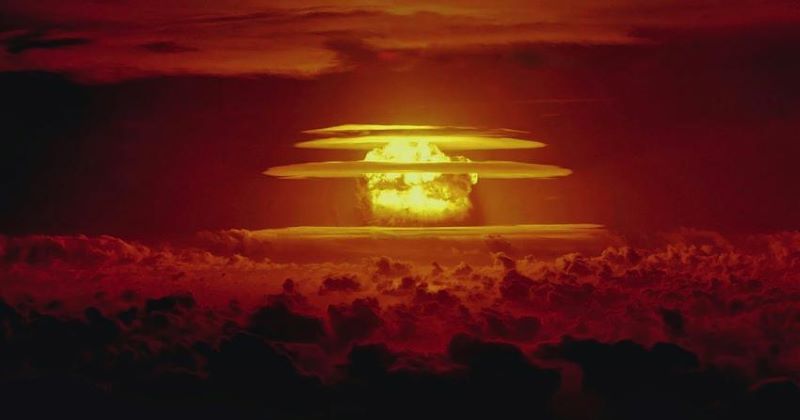ChatGPT and Kelly Kizer Whitt created a 3-point summary for the longer article below:
- Scientists say underground nuclear tests are now 99% detectable, thanks to a new detection technology.
- They created the new detection method by analyzing nuclear tests and earthquakes in Nevada.
- They say nuclear secrecy may be a thing of the past, raising hopes for better enforcement of treaties and arms control measures aimed at curbing nuclear proliferation.
The Royal Astronomical Society published this original article on February 7, 2024. Edits by EarthSky.
Underground nuclear tests no longer a secret
Secret underground nuclear tests could now be a thing of the past thanks to a major scientific breakthrough in ways to identify them.
A team of Earth scientists and statisticians say they can now tell with 99% accuracy if there’s been an underground nuclear explosion. This is up from 82% and based on a dataset of known tests in the U.S. The researchers published their new study in the Geophysical Journal International on February 7, 2024.

How to detect underground nuclear tests
It has previously been tricky to differentiate between nuclear explosions and other seismic sources. The other sources include naturally occurring earthquakes or manmade noise above ground. Lead author Mark Hoggard, of the Australian National University (ANU), said:
The explosion goes off and you have all this energy that radiates out, which we can measure on seismometers. So, the science problem becomes, how do we tell the difference between that and a naturally occurring earthquake?
This was an issue seven years ago, when several of the existing methods used to identify underground nuclear explosions failed to establish that North Korea had carried out such a test.
The secretive communist state later confirmed it had successfully tested a weapon with a force of between 100 to 370 kilotons. For comparison, a 100-kiloton bomb is six times more powerful than the one the U.S. dropped on Hiroshima in 1945.
Nations testing nukes
North Korea is the only country known to have carried out an underground nuclear test in the 21st century. But satellite imagery revealed last year that Russia, the U.S. and China have all built new facilities at their nuclear test sites in recent years.
Although there is no suggestion the three superpowers are planning to resume such experiments, the war in Ukraine has made the global security landscape uncertain. Hoggard said:
By using some revised mathematics and more advanced statistical treatment, we have managed to improve the classification success rate from 82% to 99% for a series of 140 known explosions in the U.S.
Nuclear testing in the U.S. has largely been carried out in Nevada – in the desert – and there is a thorough seismic record of all those tests, so it provides a really helpful dataset.
Our new method also successfully identifies all six of the tests conducted in North Korea from 2006 to 2017.

The 1%
Hoggard said there may still be instances of underground nuclear tests being carried out surreptitiously in some parts of the world. And the sheer volume of earthquakes makes it difficult to investigate each event to determine if it is suspicious or not. Hoggard said:
This makes effective methods like ours all the more important. It also doesn’t require any new kit. You don’t have to put up satellites or anything like that, we’re just using standard seismic data.
Hoggard described the model as “pretty fast,” making it “more or less suitable for real-time monitoring.”
A team of Earth scientists and statisticians working at ANU and the Los Alamos government research lab in the U.S. carried out the research. They say the new approach:
… provides a means to rapidly assess the likelihood of an event being an explosion.
Researchers built the mathematical model by analyzing the physical differences in the pattern of rock deformation at the source of nuclear explosions and earthquakes. This allowed experts to determine which seismic event a recorded noise is more likely to belong to.
Political solutions and monitoring
International efforts shifted to monitoring significant seismic waves in the aftermath of the Cuban Missile Crisis and Partial Nuclear Test Ban Treaty in the 1960s. That treaty limited the testing of nuclear weapons to underground only.
Officials introduced the agreement following years of environmentally damaging experiments carried out at the surface and/or underwater. These polluted many locations and – in some instances – led to catastrophic levels of radioactive fallout.
But the new monitoring required by the treaty brought challenges. Primarily, nuclear explosions and other seismic sources must be differentiated.
It has taken more than six decades, but the scientists behind the new research believe their innovative method could now make this a lot easier for groups such as the Comprehensive Nuclear-Test-Ban Treaty Organization (CTBTO). The CTBTO’s job is international surveillance of nuclear testing.
Hoggard said his team’s mathematical model would be:
… another tool in CTBTO’s armory for detecting any potential underground tests that are conducted in secret.
A ban on all future tests is unlikely given that several major nations remain unwilling to ratify the Comprehensive Nuclear-Test-Ban Treaty.
Well-supported monitoring programs are therefore critical for ensuring that all governments are held accountable for the environmental and societal impacts of nuclear weapons testing.
Bottom line: New science is now able to detect 99% of underground nuclear tests, which will help keep tests from being conducted in secret.
Via Royal Astronomical Society
Read more: Effects of nuclear war on Earth today: ‘Not winnable’











